What Went Wrong With The Wolfman? How Makeup VFX Legend Rick Baker Was Pushed Aside For CGI Junk
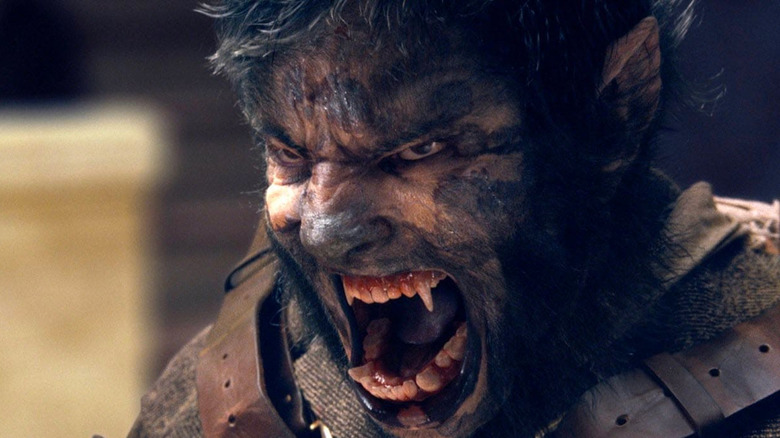
Rick Baker is a legend. The special makeup effects master is responsible for creating work for "Videodrome," "Thriller," "Harry and the Hendersons," "Coming to America," "Men in Black," "The Nutty Professor," and so much more. His work is iconic (and I don't use that word lightly) and arguably unparalleled. Hell, he won the very first Oscar for Best Makeup for his groundbreaking work on "American Werewolf in London," and he would go on to win the award a record seven times. In short, Rick Baker is one of the best to ever do it.
Not only is Baker an artist, but he's also a fan of the classic makeup work of cinema, particularly the Universal Monsters, most of which were created by Jack Pierce. So it makes sense that when Universal decided to remake "The Wolfman," Baker would want to be on board to bring the lycanthrope to life. Baker himself went to the studio when he learned of the remake, and one of his first questions was whether or not the film was going to use CG, or practical makeup. The studio told Baker that they were going the makeup route, to which Baker replied: "I do makeup, and I'm a big 'Wolf Man' fan."
But the claims that makeup was the only way to go on "The Wolfman" proved to not be entirely true. Ultimately, Baker, the guy who pretty much invented the modern practical werewolf transformation, was pushed aside to make way for CGI junk.
'I'm A Fan Of Those Old Horror Movies'
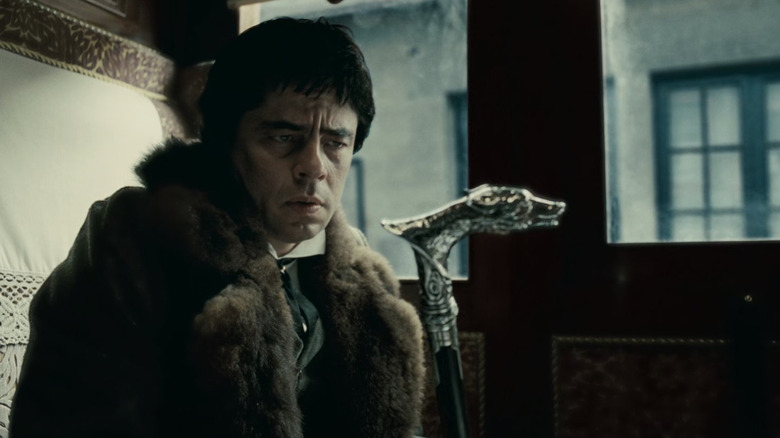
"The Wolfman" feels like a massive missed opportunity. You can see hints of a much better movie lurking in the shadows, but they never come into the light. It's like a puzzle missing one final piece. A remake of the 1941 Universal classic "The Wolf Man," the 2010 "Wolfman" came about as a passion project for star Benicio del Toro. The book "Rick Baker: Metamorphosis" by J. W. Rinzler features a lengthy breakdown of the film's troubled production, where del Toro is quoted as saying:
"I'm a fan of those old horror movies ... I have this poster of Lon Chaney Jr. as the Wolf Man in my house. My manager came by one day and saw it and said, 'We should propose this to Universal.'"
Universal went all-in on the pitch, and Mark Romanek, director of "One Hour Photo" was brought in to helm. The plot would be somewhat similar to the original film — Lawrence Talbot returns to his ancestral home, gets bitten by a werewolf, and becomes a werewolf himself. And to bring Benicio del Toro's Wolfman to life, Rick Baker was called in to work his makeup magic. Baker would team up with makeup supervisor Dave Elsey to get the job done (along with a crew of about 45 to 65 people).
But "The Wolman" was off to a rocky start almost immediately.
Bad Moon Rising
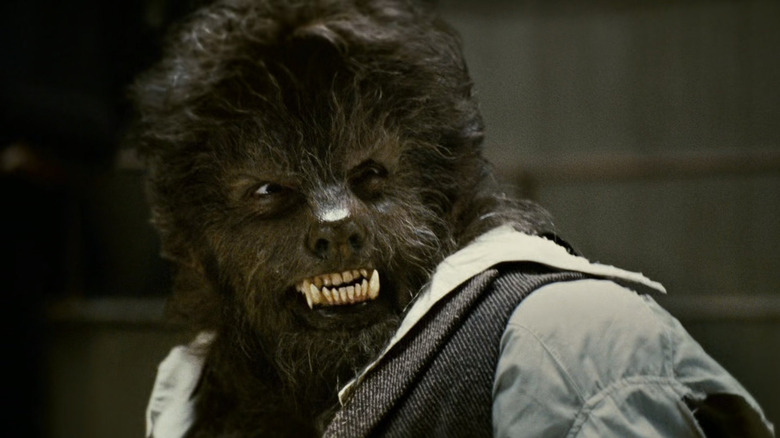
Per "Rick Baker: Metamorphosis," Baker spent considerable time creating possible looks for the new Wolfman, but after seven months, director Mark Romanek still hadn't signed off on any. "It turned into a nightmare," Baker said. "Months and months, with no decisions made." The indecision got so bad, and stretched on for so long, Baker stated that he thought he was "going to die" from the stress.
Eventually, Romanek walked from the project due to creative differences, and Joe Johnston, the filmmaker behind "The Rocketeer," which Baker worked on, and the future director of "Captain America: The First Avenger," took over directing duties, promising to shoot the film faster than Romanek. But the look of the Wolfman continued to languish in limbo. As Dave Elsey said:
"We'd have meetings that went on for hours and hours and hours ... and we would talk about the movie's themes, we'd talk about every conceivable thing but the wolfman. What would the door be like that he comes through? How would the glass be made that goes in the windows? What kind of doorknob? Would the floor be wood? When we'd finally get to the wolfman, Romanek would just space out, so we were getting really nervous."
Finally, Baker put his foot down and decided on a final look himself. Johnston signed off on it, and Baker and his team got to work creating the makeup.
There, Wolf
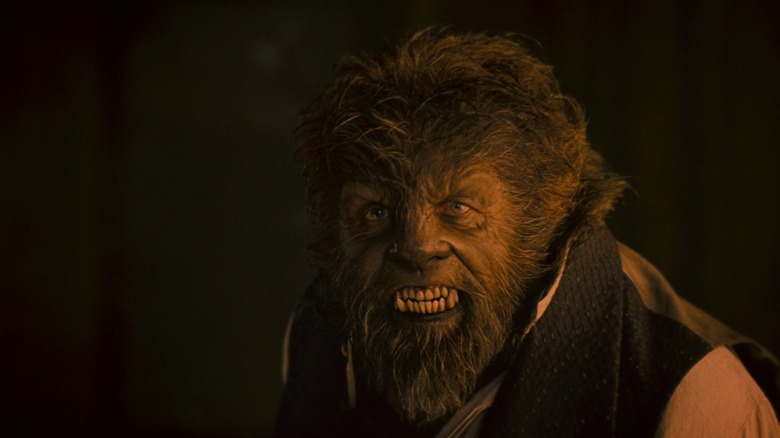
Here's the thing: the makeup that actually shows up in "The Wolfman" looks great. That's no surprise, really, since Baker is so damn good at what he does. Fully transformed, del Toro's Talbot is still able to move his face; to snarl, to growl, to look genuinely threatening. He looks like a man transformed into a monster (as does a second werewolf, Talbot's father, played by a deliberately hammy Anthony Hopkins). The makeup aids the film's gothic vibe, with its foggy fields, gothic buildings, graphic violence, and music by Danny Elfman that owes more than a few things to Wojciech Kilar's magnificent "Bram Stoker's Dracula" score.
But any time the film relies on CG, your stomach sinks. Before we even get to the CG Wolfman, we're "treated" to a CG bear that looks like it wandered in from a 1990s Disney movie. CG is not automatically disqualifying for a film, and some of the best usages of the art come in conjuction with practical effects. Think of "Jurassic Park" — the reason the VFX in that film holds up so well is that Steven Spielberg and company combined both digital work and physical models. So, in theory, combining CGI and makeup on "The Wolfman" could've worked. Even Elsey stated "I want to make it absolutely plain that the CG department [...] were great and they loved Rick," adding:
"They loved Rick's work, and they kept arguing all the time, saying 'You should do this part practical, and then we'll do this part CG.' We were completely on the same page."
Then it came time to shoot the transformation scene.
The Coolest Werewolf Movie
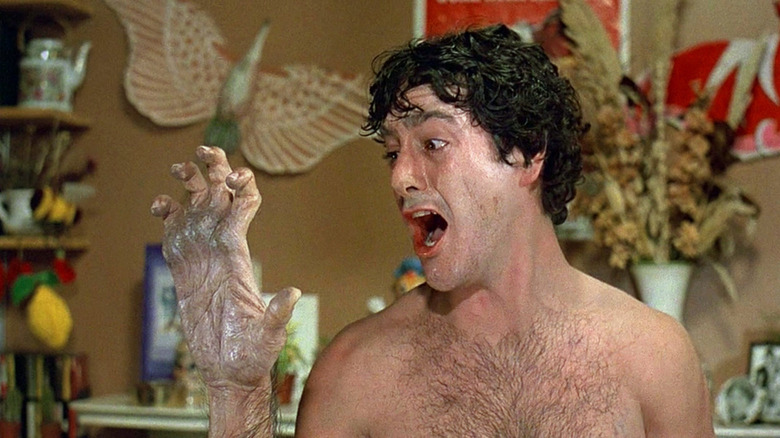
The werewolf transformation is one of those bits of movie magic that always thrills me (when done well). There's just something charming (in, ya know, a terrifying way) about watching an actor be transformed into a creature. In the good old days, this was all done practically — because there was no other choice. Universal's original "Wolf Man" used a shot-by-shot method to bring out the werewolf. Actor Lon Chaney Jr. was forced to sit for hours as Jack Pierce's makeup was meticulously applied to his face piece by piece. The camera would snap an image, wait, snap another. The end result is both crude and perfect, as Chaney's human face slowly dissolves into that of the Wolf Man.
As makeup advanced, the opportunity for bigger, better werewolf transformations presented themselves. And it was Baker who broke the mold. He had previously worked on "American Werewolf" director John Landis' first feature, "Schlock," so when it came time to make his werewolf movie, Landis called in Baker. "I really wanted to make this the coolest werewolf movie we could make," Baker said. Landis wanted to do a brand-new kind of werewolf transformation for the film, and came up with the idea of showing a human body going through agony as it transformed. Baker wanted to try to find a way to shoot the entire thing in one shot, but that proved to be impossible. Using props, makeup, fake torsos, and bulging bladders, Baker's "American Werewolf" transformation is both jaw-dropping and terrifying — and it won him that first Best Makeup Oscar.
And yet, when it came to "The Wolfman," Universal decided to push the man who invented the modern werewolf transformation scene aside.
'Don't You Want To Even Try It?'
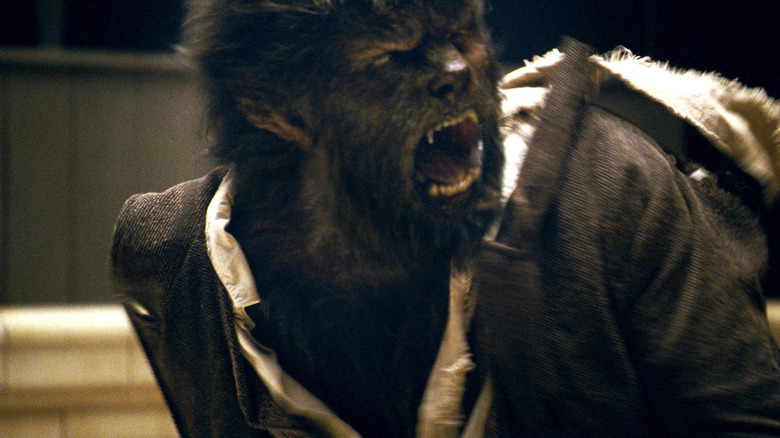
According to "Rick Baker: Metamorphosis," when the day came to shoot the big transformation scene, Baker and his team were not listed on the call sheet. They went down to the set to see what was happening, only to find Benicio del Toro mimicking transforming into a wolf. It was then that Baker and company learned that the filmmakers had decided to make the transformation scene CGI. This was understandably confusing to the Baker team, since they had spent considerable time developing a practical transformation scene, and were ready to go.
Dave Esley said of the experience:
"We said, 'But we have all this stuff. It's all ready to go. Don't you want to even try it?' And they said, 'Nope.' Rick was so gutted ... We'd built 90 percent of it and planned it out, and it was very original, very clever, and real innovative; Rick was honestly, truthfully, heartbroken about it, and it broke my heart as well."
Baker confirmed his annoyance, stating: "I was intentionally left out of the filming of the transformation, which is stupid ... I poured my heart and soul into it." The transformation scene that appears in the film is legitimately awful. The werewolf hair is too smooth, lacking texture. And the body parts twisting and elongating look like a full-blown cartoon. None of it works, and it's even more jarring when the scene ends and we see del Toro's Wolfman wearing practical makeup. You want to ask, "Hey, where'd that cartoon that was just here go?" It's also baffling — if Baker and the team were ready to go with something practical, why not shoot it? The answer is surely time and money — the producers wanted the scene done fast and cheap, and the movie suffers because of it.
Baker and his team perhaps had the last laugh, winning an Oscar for their work (the only Oscar the film won). But watching "The Wolfman" continues to disappoint. I find myself revisiting it from time to time, thinking, "Well, maybe this time I'll like it more." That's not such an outlandish thought — opinions on films change. But "The Wolfman" remains a slog; there's no life in the film, save for Baker's stunning makeup. And I can't help but think that if the filmmakers had gone with his practical transformation scene, the film would be far more successful. It feels like an insult, not to just Baker but to his fans, that we'll never get to see what he created.
Read this next: The Horror Movies We Can't Wait To See In 2022
The post What Went Wrong With The Wolfman? How Makeup VFX Legend Rick Baker Was Pushed Aside for CGI Junk appeared first on /Film.
